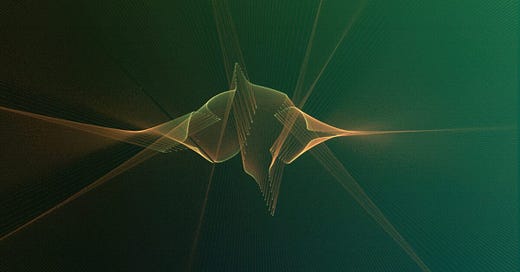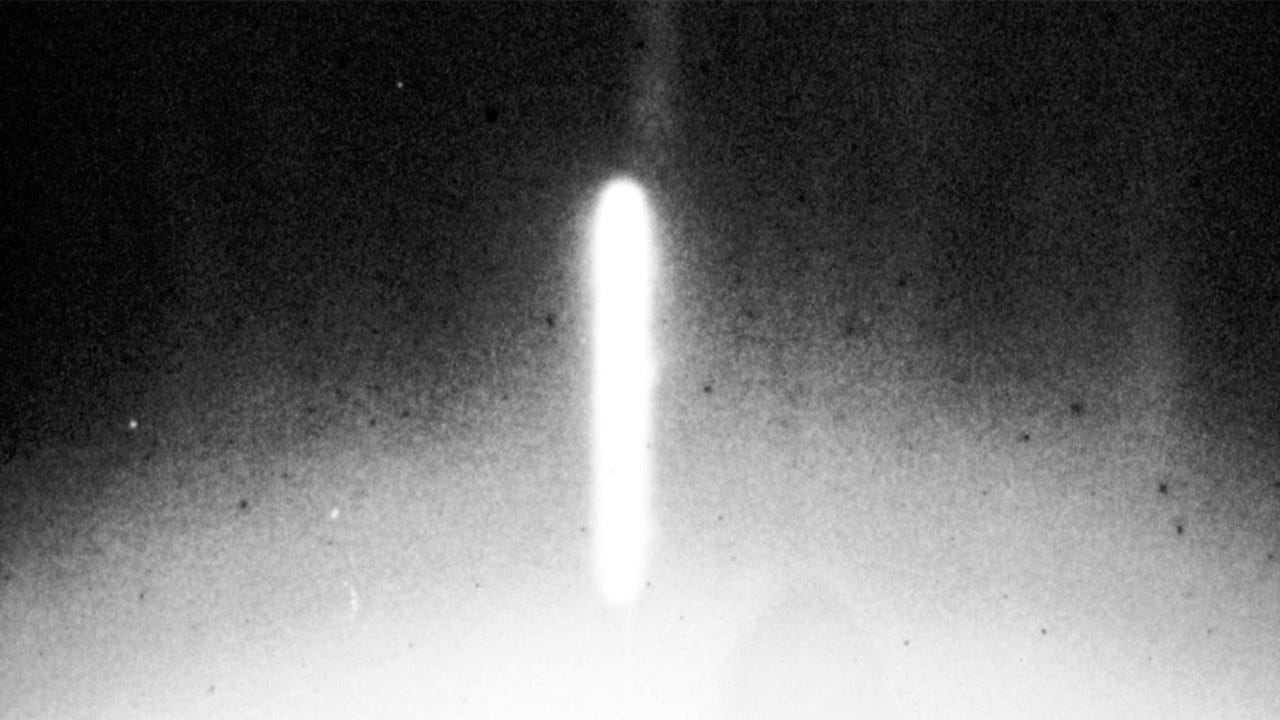Nine films from Light Matter's 2023/24 programs
Mechanisms Common to Disparate Phenomena: #59 (Joost Rekveld)
At their best, Joost Rekveld’s films have felt like glimpses into secret patterns that underlie our physical reality. His highly conceptual works are usually based in some sort of abstraction—an equation or pattern or application of chaos theory—which is then used to to generate slowly evolving visual elements. Cousins to the tradition of visual music and to contemporary artists like Takashi Makino, they often look something like a crystal formation or a media player visualizer, except that in previous works sound has been background element accompanying the images.
Rekveld’s latest, Mechanisms Common to Disparate Phenomena, is a huge conceptual leap forward that retains the beauty of his visual patterns while deeply interrogating their seeming abstraction. After a prologue detailing key discoveries that led to chaos theory, the bulk of the film uses sound—including music, field recordings, and found sound from mid-century sci fi B movies—to create a web of meaning nearly as intricate as the geometric patterns on screen.
Technology and scientific theory are placed in historical and political context, shown as inseparable from these forces that structure human perception and use of them. The film investigates the military origin of many computer technologies, uses film dialogue about aliens and cyborgs to emphasize the specificity of human experience, and plays with the narratives we project onto abstraction through the use of field recordings. Mechanisms feels like the culmination of ideas Rekveld has been hinting at for a long time and has finally realized in a major work.
Kolaswvt Vfulles (Arvcúken Noquisi)
“Space: the final frontier” are the first words spoken in Arvcúken Noquisi’s anti-colonial Star Trek parody, kolaswvt vfulles. The Enterprise flies by with a list of “Greek by blood” individuals written over it, followed by a scroll through pages of search engine results for “native american.” A still image of a cowboy with a Federation badge appears and invites us to look at his website full of “cool indians.” Noquisi reappropriates settler culture to critique its pretensions, suggesting that there’s little fundamental difference between the utopian “final frontier” imagined by its sci-fi visions of the future and the violence of the American “frontier” as romanticized in the Western.
To drive this point home, Noquisi borrows footage from a Star Trek episode (“The Paradise Syndrome”) where Kirk visits a planet whose inhabitants are descended from Native Americans. These “Indians'' are apparently frozen in time, a relic of settler culture’s imagined, primitive past beamed into its idealized future. This footage is slowed to a stuttering pace in the style of Martin Arnold’s 90s films (e.g. Passage à l’Acte), and like Arnold’s work it hopes to reveal something of the hegemonic assumptions that structure these scenes. The technique is not as successful here; the politics are blunt, the aesthetics rough. But that’s part of the point, the visibly barebones technique and layered textual interruptions breaking the audience’s identification with sci fi as a narrative mode in order to clarify its ideological foundations.
Kolaswvt vfulles ends with a rudimentary animation of a futuristic vessel speaking Muscogee, the center of which dissolves into swirling dots and colors which coalesce from a galactic spiral into figures performing a ceremonial dance. The film doesn’t quite find the formal means to deliver its aspirational conclusion, but it’s a hopeful one: there are alternative visions of the future which don’t replicate the assumptions of a genocidal past.
In the Fishtank (Linnea Nugent)
Linnea Nugent seems to ave really hit her stride the last couple of years, crafting consistently memorable miniatures at the boundary of embodied subjectivity and larger conceptions of the natural world. Her new triptych In the Fishtank might be her most condensed and impactful set of images to date. The first image is a fairly static black and white shot of a tree which seems to be frozen in ashen time. The second is a white horse in a bright green field that flickers in and out of shadow. The last and briefest is a glowing red forest scene barely visible between blurred focus and an enveloping darkness that could be blinking eyelids. All three sections carry a distinctly luminescent visual character alongside the threat of its extinction through darkness. It’s otherworldly yet human, and suggests the specificity and irreducibility of our experience of nature.
it follows it passes on (Erica Sheu)
It Follows It Passes On continues Sheu’s recent project of familial autobiography, summoning a world of feeling and memory in a set of condensed images. Her last couple of films were dedicated to her grandmother, but this one is about her father. The central motifs are a burning stick of incense and series of close shots of sand and dirt and glass, sometimes encased in aquarium-like containers. The images are beautiful and precise, at times recalling Dorsky’s macrophotographic work from the 80s and 90s.
Aside from some text at the beginning of the film that references Sheu’s father’s childhood and a joke about “hiding from the bomb,” there’s nothing here to tell us how these images are connected, but that isn’t the point. Sheu is working in a concentrated form of visual expression akin to an imagistic poem, and we can feel its generational resonance even without biographical knowledge.
Stained Night (Andrés Medina)
True to its title, Stained Night begins with a black screen, from which emerge points of light and smoky clouds of color. The initial point of reference is indeed something cosmic in the night sky, but these images are transparently the product of digital video grain and distortion. As they settle into more recognizable form, it becomes clear that what we’re seeing is the lights and crowd at a concert, but there’s no music to be heard. Artist Andrés Medina’s choice to leave the film silent is key, allowing his work to represent the delirious haze of a collective experience without becoming a mere accompaniment to music. The film fades from focused pans of a crowd to abstract blurs of light and color much as a concertgoer’s attention might slip from an awareness of their surroundings to a broader sense of nocturnal bliss. It’s one of the more pointed recent examples of how silence can be as sharp a choice as any soundtrack.
de-composition (Laura Kraning)
Laura Kraning’s de-composition is built from a series of rapidly alternating close shots of metal in various states of rust. Structurally, it recalls Brakhage’s hand-painted works and various other avant-garde films that generate animation through direct, out-of-camera manipulation of celluloid frames. Like many of those works, de-composition finds abstract patterns of beauty at the same time that it speaks to the ephemerality of material surfaces. By looking outward at the micro-landscape of a rail line, Kraning addresses at once our understanding of material environments and the representation capacity of a specific medium, making this something of a bridge between her earlier environmental films and the traditions of experimental animations.
Next Her Heart (Anna Kipervaser)
Next Her Heart is decidedly mythological in tone, even if you have no previous knowledge of the specific Persian mythology it references. Kipervaser organizes her film around motifs and contrasts suggestive of the most eternal themes of life, death, and regeneration. Dogs play along the shore of living waters while the dried ground is strewn with the skeletons of birds, the alternation of these image-sets suggesting a cycle or recurring journey. Many of the specific images reference the Simurgh, a benevolent and feminine dog-bird that lives near the water. This legendary creatures informs the film’s details, but there’s no coded meaning to unlock; the work’s strength is in the ambiguous universality of its images.
NYC RGB (Viktoria Schmid)
Viktoria Schmid’s NYC RGB is a semi-structural city symphony in a minor key. Shot over just a few days, it features several minutes of skyscrapers and rooftop shots. All of this is familiar from a century of NYC avant-garde film, from Manhatta (1921) to Shirley Clarke and Jim Jennings. Schmidt’s distinctive move is to use several prints of her footage with varying color filters, such that certain objects in frame are rendered in overlapping sets of semi-translucent primary color. The effect is particularly striking when applied to clouds, where it results in a cotton-candy like rainbow haze, and to the clearly delineated shadows across the roof of a building, where it creates an abstract geometry of color. NYC RGB is a modest film, conscious of its place in the tradition, but a lovely one.
Cellula Filia (Piibe Kolka)
Cellula Filia puts past and present in direct conversation in an attempt to understand family and place. A thread falls at the beginning of the film, connecting the artist, Piibe Kolka, to her grandmother, who made clothes. More lines and threads appear throughout the film as both visual and narrative motifs. A thread is spun back and forth across a room between support pillars. The lines of a topographical drawing suggest human figures, and the film explores the idea of epigenetic inheritance of traits as a feature of both landscape and human generations. Voiceover narration slips between the grandmother’s time and the present, and tells a story of the former building a cable to allow small boats to cross a river directly instead of taking the long way around to a bridge down South–a further metaphor for the film’s attempt to collapse the span of time and find some direct view of the past.
The notion of cinema as a way to bridge the generations is not just a metaphor for Kolka, but a part of her family history. Her grandfather opened his town’s cinema and operated it for years. Later, she returns to the town and tries to find the location of the cinema, which is closed, another relic to be uncovered. The chairs of the cinema become a further motif, as throughout the film the artist is seen holding a chair up with one hand, a game to see how long she can maintain the balancing act. Inevitably it ends, and it’s never long enough. We can strive to preserve and remember the past through art, but this will always be the long way around.






